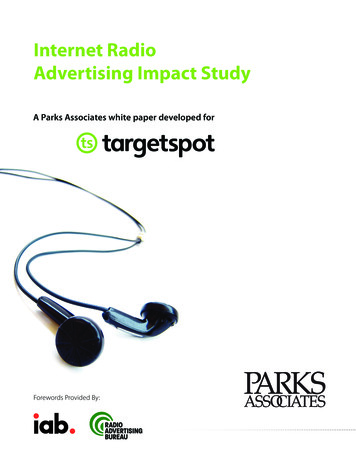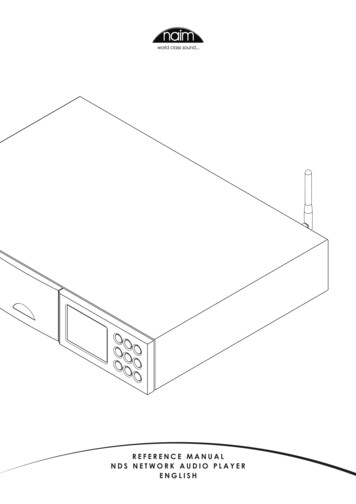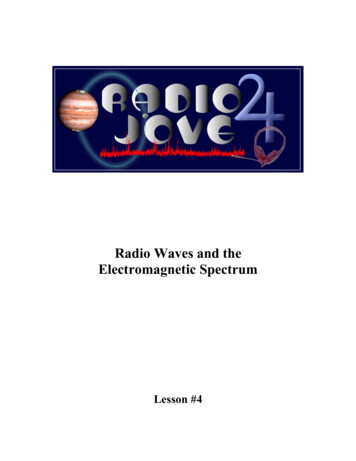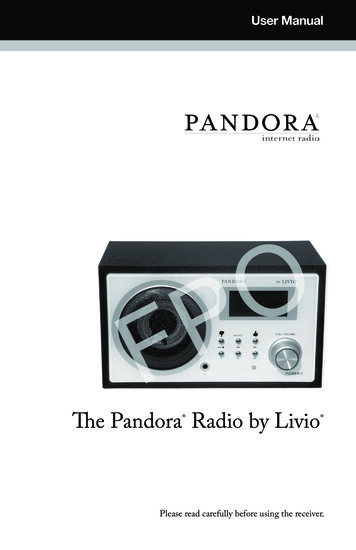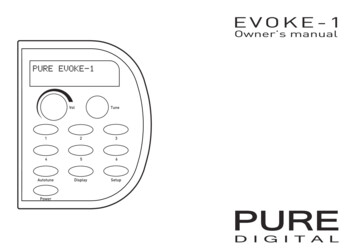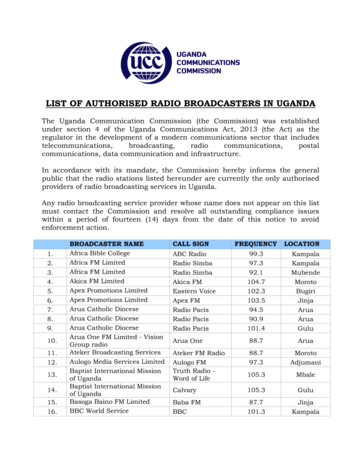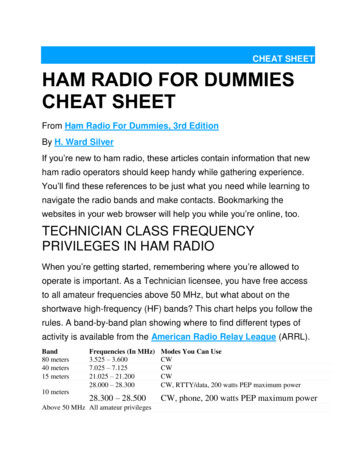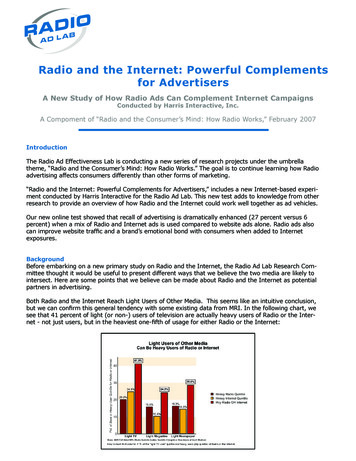
Transcription
Radio and the Internet: Powerful Complementsfor AdvertisersA New Study of How Radio Ads Can Complement Internet CampaignsConducted by Harris Interactive, Inc.A Compoment of “Radio and the Consumer’s Mind: How Radio Works,” February 2007IntroductionThe Radio Ad Effectiveness Lab is conducting a new series of research projects under the umbrellatheme, “Radio and the Consumer’s Mind: How Radio Works.” The goal is to continue learning how Radioadvertising affects consumers differently than other forms of marketing.“Radio and the Internet: Powerful Complements for Advertisers,” includes a new Internet-based experiment conducted by Harris Interactive for the Radio Ad Lab. This new test adds to knowledge from otherresearch to provide an overview of how Radio and the Internet could work well together as ad vehicles.Our new online test showed that recall of advertising is dramatically enhanced (27 percent versus 6percent) when a mix of Radio and Internet ads is used compared to website ads alone. Radio ads alsocan improve website traffic and a brand’s emotional bond with consumers when added to Internetexposures.BackgroundBefore embarking on a new primary study on Radio and the Internet, the Radio Ad Lab Research Committee thought it would be useful to present different ways that we believe the two media are likely tointersect. Here are some points that we believe can be made about Radio and the Internet as potentialpartners in advertising.Both Radio and the Internet Reach Light Users of Other Media. This seems like an intuitive conclusion,but we can confirm this general tendency with some existing data from MRI. In the following chart, wesee that 41 percent of light (or non-) users of television are actually heavy users of Radio or the Internet - not just users, but in the heaviest one-fifth of usage for either Radio or the Internet:
Radio and the Internet Connect with Consumers in Unique WaysIn the Radio Ad Lab’s previous study, “Personal Relevance Two: Radio’s Receptive Ad Environment,”it was clear that Radio and the Internet build complementary kinds of bridges to the consumer’smind. To paraphrase from that 2006 study (available for free at http://RadioAdLab.org): Radio ads may be more effective at making emotional connections with consumers, thanks to themuch more emotional link that listeners have with the medium itself.The Internet, meanwhile, connects at a more factual level, providing information that “helpsyou understand what is going on in the world around you.”Radio Can Drive Traffic to WebsitesResearch in the UK (from the UK’s RAB and IAB) indicated that 57 percent of those who listen toRadio while online say they’ve “checked out things on the Internet after just hearing about them onthe Radio.” And 67 percent said that “hearing things on the Radio will remind me to look up something when I’m using the Internet.” We explore this idea further in the new Radio Ad Lab studydescribed below.Radio and the Internet Have Unique Reach Patterns .and that can make them work powerfully in combination. When you put those two media together,we found that the daily reach of Radio and the Internet is similar to that of television. This nextchart uses Knowledge Networks data to provide estimates of combined-media total reach, controlling for duplication, and it shows that on a daily basis, Radio and the Internet together reach about83 percent of the 18-54 population.Radio and the Internet: Powerful Complements for AdvertisersPage 2
Radio Is Often Used Simultaneously with the InternetOur background research also confirmed that “simultaneous usage” is another important way to thinkabout Radio and the Internet. Here’s a look at how much Internet usage involves simultaneous usage ofRadio and TV, by daypart:Up to a third of Internet usage time includes simultaneous Radio listening in some dayparts (especially during the day), and that’s true even for teens and young adults.The New StudyWith that background, the Radio Ad Lab’s Research Committee designed a new online test of how wella mixture of Radio and Internet ad exposures actually can work. We suspected that a mix of Radio andInternet ads might be more impactful than website ads alone, but we found no published research thatactually assessed that possibility. Using multiple media has become common advertising practice, butwe thought research was needed on this particular combination’s actual effectiveness.Using Harris Interactive’s research panel of Internet users, we ran a test in late 2006 that comparedthe effects of two exposures to website ads to a mixed exposure of one website ad and one Radio ad.The details of the study design are in the full White Paper available for free download at http://RadioAdLab.org. But briefly:We used a misdirection method in which respondents were asked to evaluate content rather thanadvertising. Advertising was embedded in the content, and the ad effects were measured after exposure to the content. Respondents had a choice of six different types of Radio programs and six differentwebsite types for their “evaluation.”The full paper focuses on the results of two test cells - two matching groups of participants whowere exposed to one or the other of the following conditions: Two Internet: Two exposures to an Internet ad.One Internet, One Radio: One exposure to an Internet ad, and one exposure to the correspondingRadio ad. 1As explained in detail in the full paper, the Radio Ad Lab alsoattempted to include a third test cell that featured one website adand two Radio ads. But Harris Interactive believes that cell was over-burdened, and the results were confounded by “researcheffects” that kept it from being useful for analyzing ad effectiveness.1Radio and the Internet: Powerful Complements for AdvertisersPage 3
We achieved about 800 completed interviews in each of those test groups. The ads used in the testcame from eight actual ad campaigns in a wide variety of product categories. Each of those campaignsactually had used both Radio and website advertising. The Radio ads were all 30s; the related websiteads were a mixture of static images, animated images, and Flash animation of varying sizes.The Key ResultsWe used a variety of effectiveness measures in this study. The ones which we think best reflect themedia effects are simple measures of brand recall. Recall of an ad’s brand content is the first step inadvertising success, and it’s less dependent on the specific quality or targeting of an ad.For that reason, we believe, it was with recall measures that we saw the most striking effects. Asyou can see in the chart below, unaided recall for the mix of one Internet and one Radio exposure forthese advertisers was four-and-a-half times as high as the unaided recall for two Internet ads alone.The aided recall results (in which those not recalling advertised brands without prompting were thenshown a list of brands) were consistent with the unprompted results. The mix of one Radio and oneInternet exposure had more than twice the aided recall of two Internet ads.Radio and the Internet: Powerful Complements for AdvertisersPage 4
We analyzed these findings by a variety of different demographic cuts, and the strong effects for the Radiomix exposures were consistent across the board. For example, in the chart in the next column, here’s howunaided recall looked by age group:While the differences here are striking, the Radio Ad Lab wasn’t entirely surprised with these findings. Not onlyare they directionally consistent with our past work on media synergy (“Benefits of Synergy,” 2005), but theyalso are consistent with current thinking in media about the value of using multiple communication channels toreach consumers.In the full White Paper, we also discuss the findings from a number of other effectiveness measures,including: Website Visitation (likelihood of visiting the advertiser’s website)Purchase Likelihood (definitely/probably will purchase, etc.)Brand Consideration (the only brand you consider/one of the few, etc.)Brand Emotional Connection (you love/like the brand, etc.)Brand Aspirational Fit (perfect/good fit for how you see yourself, etc.)For these measures, the quality and targeting of the individual ads made a difference in the results. But asspelled out in more detail in the White Paper, we found that: Five of the eight brands experienced greater impact with a Radio/Internet mix on Website Visitationand Purchase Likelihood. Some of those differences were statistically significant, even at the brandlevel.Four of those five brands also showed better Radio/mix results on Aspirational Fit and Emotional Connection. Some of those differences were statistically significant, even at the brand level.The other three brands tended to show comparable effects for the Radio/Internet mix as for the Internet-only mix; there were no statistically significant differences for those brands.Radio and the Internet: Powerful Complements for AdvertisersPage 5
ConclusionsThis project started with some background research about how and why Radio and the Internet might be goodpartners in advertising. We observed the following, in part: Both reach light users of other media.Radio and the Internet connect with consumers differently, and in potentially complementary ways.Radio can drive traffic to websites.Radio and the Internet have unique reach patterns, and that can make them work powerfully in combination. On a daily basis, Radio and the Internet together reach about 83 percent of the 18-54 population, nearly that of television’s daily reach.Radio is often used simultaneously with the Internet, with up to a third of Internet usage being accompanied by Radio listening during some times of the day.Now, with our new experiment from Harris Interactive, we see some strong evidence that people exposedto both Radio and website ads are impacted more strongly than those exposed to website ads alone: Unaided recall for the mix of one Internet and one Radio exposure for these advertisers was four-anda-half times as high as the unaided recall for two Internet ads alone. And the mix of one Radio and oneInternet exposure had more than twice the aided recall of two Internet ads.Furthermore, a mix of Radio and Internet exposures also demonstrated clear potential to elevate otherkinds of consumer impact, ranging from website visitation to emotional bonds, when the Radio ads themselves are impactful. Five of the Radio campaigns tested were especially effective.Overall, the picture seems clear: Radio and the Internet can be powerful advertising complements. Whetherthe goal is to reach more people, or to reach them with greater impact, this particular combination of mediaseems to be a recipe that’s worthy of more consideration.Radio and the Internet: Powerful Complements for AdvertisersPage 6
Radio Ad Lab Board of Directors andResearch CommitteeThe Radio Ad Lab Board of Directors is comprised of radioindustry executives from the funding organizations and fromother key broadcasting constituencies. For more detailed information, and to view a list of the Board members, pleasevisit our website.The Radio Ad Lab Research Committee is responsible fordetermining the direction of all research projects funded by theRadio Ad Lab and includes members from the advertising andclient communities in addition to the Radio industry. ResearchCommittee members are:Radio Ad Lab Research Committee: Chair - Jerry Lee (WBEB-FM)Agencies: Paul Hunt (Burrell Communications); Alyce Abbe(Carat); Shari Anne Brill (Carat Insight); Janice Finkel-Greene(Initiative Media); Matthew Warnecke (Mediacom); Kim Vasey(mediaedge:cia); David Shiffman (Mediavest Worldwide); JeffVoigt (Mindshare Team Detroit); Agnes Lukasewych (MPG);Kaki Hinton (MPG); Natalie Swed Stone (OMD); Judy Bahary(Starcom Mediavest); Helen Katz (Starcom Mediavest Group);Michele Buslik (TargetCast);Irene Katsnelson (UniversalMcCann); Chrystie Kelly (Universal McCann); Bruce Williams(Universal McCann); J.P. James (GlobalHue); Lucilla IturraldeRachev (The Vidal Partnership); Matt Feinberg (Zenith Media)Advertisers: Jeni Cramer (At-Large); Debbie Vasquez (CocaCola North America); Betsy Lazar (General Motors); Glenn M.Roginski (GlaxoSmithKline); Mark Dorrill (The Home Depot);Paul Silverman (Novartis Pharmaceutical) ; Rex Conklin (WalMart); Ramon Portilla (Wal-Mart)Radio Ad Lab Funding PartnersArbitronAmerican Urban Radio NetworksBeasley Broadcast GroupBonneville International CorporationBuckley Broadcasting CorporationCarter BroadcastingCBS RadioCitadel Broadcasting CorporationClear Channel CommunicationsCommonwealth BroadcastingCox Broadcasting, Inc.Cromwell BroadcastingEmmis CommunicationsEntercom CommunicationsFederatedGoogleGreater Media, Inc.Hall CommunicationsHubbard Broadcasting CorporationInner City Broadcasting CompanyInterepJones MediaAmericaKatz Radio GroupMorris Network, Inc.Premiere Radio NetworksRegent Communications, Inc.Renda BroadcastingSaga CommunicationsUnivision Communications, Inc.WBEB-FMWestwood One Radio NetworksBroadcasters: Gary Heller (CBS Radio); Jess Hanson (ClearChannel Radio); Kathleen Bohan (Univision Radio); LucyHughes (CBS Radio); Charlotte Lawyer (Consultant)About The Radio Ad LabRAB: Andy Raineyunderstanding of how Radio advertising works, to measureThe Radio Ad Lab is an independent organization establishedin 2001, funded by Radio industry companies to further theRadio’s effectiveness, and to increase advertiser and agencyNetworks: Barry Feldman (American Urban Radio Networks);Len Klatt (Premiere Radio Networks); Pamela Lynott (JonesMediaAmerica); Paul Bronstein (Westwood One RadioNetworks)confidence in Radio.Rep Groups/Other Sales Organizations: Doug Catalanello(Interep); Gerry Boehme (Katz Media Group); John Park(Google)at www.RadioAdLab.org. We encourage you to sign up forAll Radio Ad Lab research, including White Papers, studies, andsummaries, is available in its entirety and for free downloadour email list at the website to make sure that you’re notifiedof new Radio Ad Lab research.Arbitron: Ed Cohen; Carol HanleyARF: Bill CookConsultant: James Peacock (Peacock Research, Inc.)125 W. 55th Street, 21st Floor, New York, NY 10019(800) 364-3239Info@RadioAdLab.orgwww.RadioAdLab.org
The Radio Ad Lab is an independent organization established in 2001, funded by Radio industry companies to further the understanding of how Radio advertising works, to measure Radio's effectiveness, and to increase advertiser and agency confidence in Radio. All Radio Ad Lab research, including White Papers, studies, and


